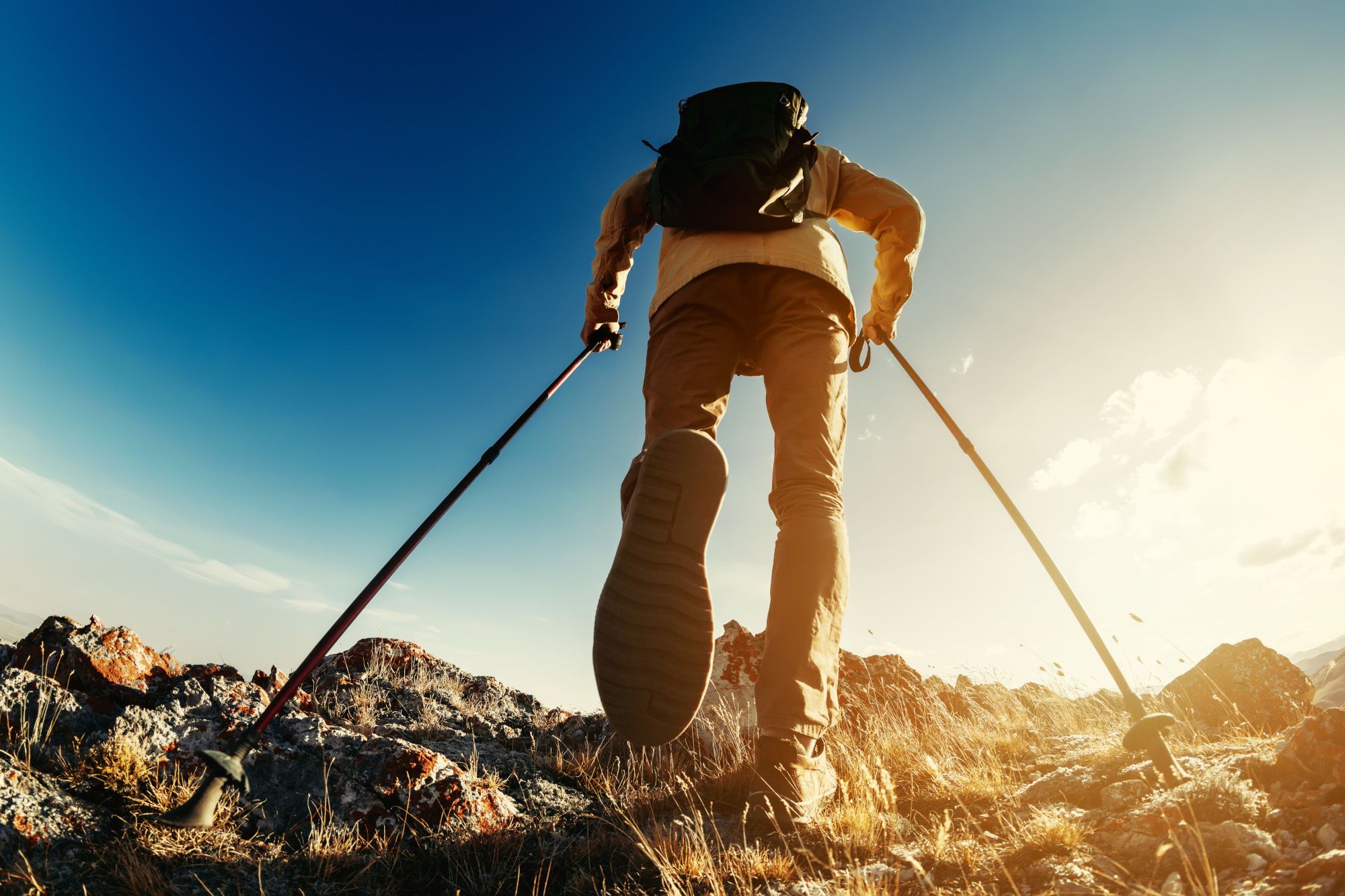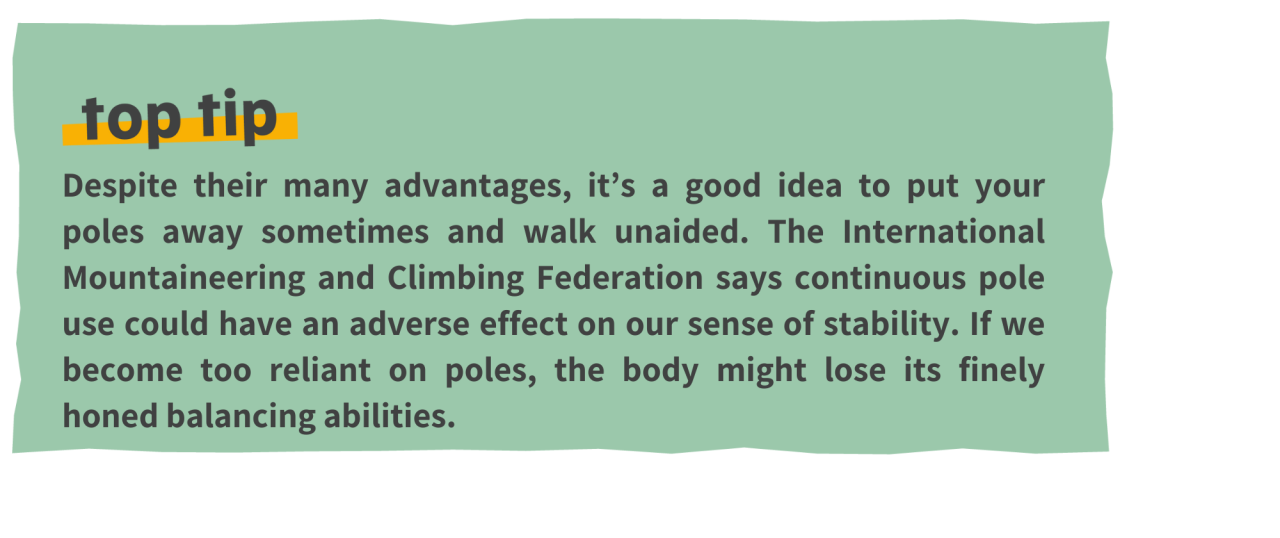Masterclass – Walking with poles

Words: Annabel Streets
Used properly, walking poles can improve posture, relieve pain, reduce fatigue and help you walk more efficiently – whatever your age or fitness level. So if you’re perplexed by poles, read on to find out how, why and when to make the most of them.
In September 1838, Henriette d'Angeville triumphantly plunged her walking pole into Mont Blanc's frozen peak. 'I finally set foot on the summit... and drove the ferule of my stick into its flank, as a soldier plants his standard on a captured citadel,' she later recalled. The second woman to scale Mont Blanc, Henriette owed her successful climb in part to her trusty sticks. Experiencing heart palpitations and extreme drowsiness, she had to pause and rest at regular intervals. As she staggered and stumbled, her sticks supported her. On perilous corners, her guides manipulated their sticks to prevent her falling to her death.
Poles past and present

Henriette's Alpine sticks - 6ft long with an iron spike at the end - weren't much like the hiking poles we use today. But her account reminds us that sticks have been used as an aid for walking for centuries. The dandy's cane gradually replaced the sword back in the 1600s, while the oak staff (perhaps inspired by Moses' miracle-performing rod) was a perennial pilgrim must-have.
Walking sticks eventually morphed into poles when cross-country skiers wanted a way to maintain their fitness during summer, but it wasn't until the 1970s and 80s that poles specifically for trekking began to be designed and sold. In the 90s the first Nordic poles appeared, developed for the so-called 'fitness walker'.
Although there's nothing new in our use of poles as a walking aid, technology has transformed them into things of mind-boggling lightness and precision. Meanwhile, studies have shown that poles can improve both our health and the way we walk.
Anyone who thinks poles and sticks are only for elderly or infirm walkers, prepare to change your mind. Adventurer Sarah Williams, founder of Tough Girl Challenges and host of the Tough Girl podcast, has been using poles since walking 2,200 miles along America's Appalachian Trail in her 30s.
'Walking poles help with my balance, reduce the impact on my knees and help me get up from the ground - especially when I have a huge backpack to contend with,' she says. But Sarah admits she didn't take to poles immediately: 'They can take a bit of time to get used to, but it's well worth persevering.' She currently walks with 'super-lightweight' Fizan poles.
Whole-body walking
Walking with poles puts the entire body to work. Our upper-body muscles - biceps, triceps, deltoids and latissimus dorsi - are engaged, so a simple hike gives an all-over workout. Nordic Walking UK founder Martin Christie says that when we walk with poles we use around 90% of our muscles. This is particularly useful after the age of 30, when our muscle mass and function begin to decline. The additional exertion means we burn calories faster, regardless of pace, speed or terrain. Our heart rate accelerates - which, according to a 2005 report, builds cardiac muscle and strengthens the heart. In other words, poles encourage our body to work harder.
The heavier the poles, the harder our muscles work. The same goes for softer terrain - we expend more energy walking on snow, sand or grass, for example, than on hard man-made surfaces. But here's the little-known magic of poles: a 2008 study found that, despite using more muscles and burning more calories, poles make us feel less fatigued. Yes, that's right - we work harder, but we perceive the exertion as being less, so we feel less tired.
Up hill and down dale

Poles come into their own on ascents and descents, making them ideal for hill walking. On steep descents, poles can help take some of the weight from our knees. On climbs, they allow the upper body to bear some of the burden, making the ascent feel less arduous. This means less muscle soreness afterwards. A 2020 study of women aged over 60 found that poles reduce the force on lower joints (knees, hips and ankles) by 12%-16%, and concluded that walking with poles reduces muscle damage when compared to walking without them.
On uneven ground, poles provide additional balance, cutting the risk of falls and improving confidence. I've found that poles are often invaluable on scree as well as in snow and mud. Poles also change the way we walk: we often adopt a longer stride with less pressure on our knees, described by researchers as a 'less flexed knee at heel strike'. We lean forward fractionally, which also reduces the weight on our knees. And, thanks to the added muscle power of our upper body, we walk slightly faster - good news for anyone wanting a speedier pace.
A recent University of Leicester study suggested a lifetime of brisk walking could make your biological age in midlife up to 16 years younger than your actual age, by extending the length of telomeres - the structures at the end of chromosomes that protect our DNA from damage.
Youthful posture
It's not just our speed, forward tilt and stride that change with poles. Our entire gait alters. Researchers found that older people who regularly use poles walk with the gait of 'young adults'. How come? The researchers think poles help slow the degradation of joint cartilage, helping us walk more youthfully.
Moreover, the benefits of walking with poles - improved coordination, balance, functional mobility and general quality of life - appear to stick around for a further five months. So, if you lose your poles, you have a few months' grace to buy a new pair!
Other researchers have investigated the effect of poles on people with Parkinson's, finding that poles improve postural stability, muscle strength, balance, mobility, coordination and speed. In fact, anyone whose gait has been affected by illness might find poles help them, says US researcher Ashley Hawke.
In studies of people suffering from backache, eight weeks of walking with poles reduced pain and discomfort - perhaps because poles encourage us to walk with a more upright stance, or because they take some of the weight from our spine. Studies have also revealed that poles can help with the counter-tipping and tilting that can be engendered by carrying a heavy backpack. Not only do we walk more normally, with fewer chances of falling, but the poles actually take some of the pack's weight, meaning less shoulder muscle soreness afterwards.
Exercise body and mind
Walking with poles requires a little extra thought and concentration, making them good for the brain as well as the body. Not only do we have to think a little about where to place our feet, but also where to place our poles. Embarrassingly, I've been known to trip over my own poles. My mind was miles away, my feet forgot and my poles were suddenly beneath my boots.
Of course, poles have many other uses, as Henriette discovered on her Mont Blanc ascent. Mine have helped me wave off overly friendly bullocks and aggressive Greek dogs, push through brambles and nettles, warn off snakes, test the depth of snow and mud, transport large spiders, keep my packed lunch off the ground, and point out directions. Come to think of it, I'm not sure how I ever walked without them ...
Annabel Streets is author of 52 Ways to Walk: The Surprising Science of Walking for Wellness and Joy, One Week at a Time (£9.89, Bloomsbury, ISBN 978 1526656445) and, as Annabel Abbs, Windswept: Why Women Walk (£10.99, John Murray, ISBN 978 1529324730).
What to look for in a pole
Weight: As light as possible – ideally less than 500g.
Aluminium or fibre? Aluminium is stronger and longer-lasting. Fibre is lighter.
Z-shaped or telescopic? Z-shaped fold up smaller, making them better suited to backpacks and hand-luggage only flights. Either way, make sure they’re adjustable
Twistlock or speedlock? You should be able to adjust or fold away your poles with minimum fuss. Try different mechanisms to find the right one for you.
Hand grip: foam, rubber or cork? Make sure the handles are ergonomically designed, the right size for your hands and comfortable to hold in sweaty or gloved palms.
Wrist straps? Look for comfortable, adjustable wrist straps - they provide extra support by taking pressure off your hands and transferring it to your wrists.
For men or women? Women’s poles are typically shorter with smaller grips. That’s the only difference. If you’re a short man with small hands, or a tall woman with large hands, don’t worry about the poles’ ‘gender’.
Pole tips: some poles offer replaceable tips and/or rubber tips for walking on tarmac. You’ll need baskets if you’re planning on hiking in snow. Make sure tips and baskets are easy to remove.
Built-in shock absorption: Worth paying for if you suffer knee or hand pain or if you’re doing a lot of descents.
Best brands? Black Diamond and Leki consistently do well in pole surveys. If you want to buy British, try Mountain King. Prices vary, but prepare to spend around £100 for a decent pair of poles.
Pole pointers
-
Angle your pole so that the tip is slightly behind you, at a 70% angle to the handle - which should be fractionally in front of you.
-
Push slightly into the ground (taking care not to damage delicate plants) and propel yourself forwards.
-
Your right pole should propel you forward as your left leg steps out, and vice versa.
-
Be sure to lengthen your poles when going downhill, and to shorten them when going uphill.
-
Use rubber tips when walking on hard surfaces.

Images: Getty Images

The ultimate guide to men's walking trousers 2024
A perfect pair of walking trousers should hit the mark in three key areas: fit, features and fabric.

The Best Lightweight Walking Shoes in 2024
If heading out for summer walks on easier trails, or keen to keep the weight on your feet to a minimum, lightweight walking shoes can be an excellent choice.

Best buys
From waterproof jackets to the ultimate walking trousers, our Best Buy articles below can help you decide which is the best walking gear for you.

